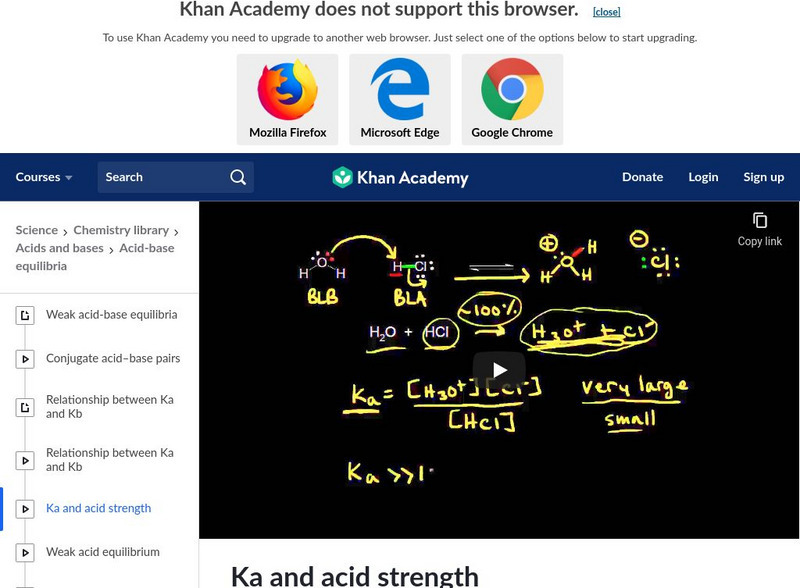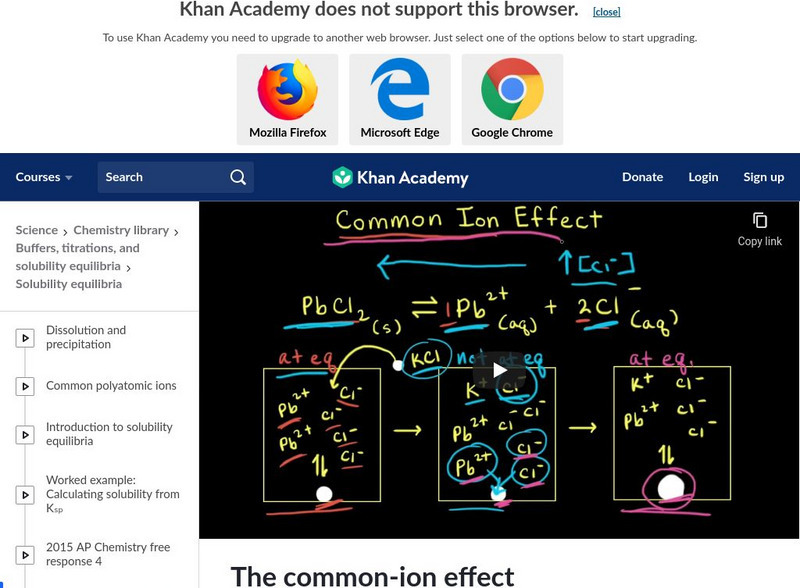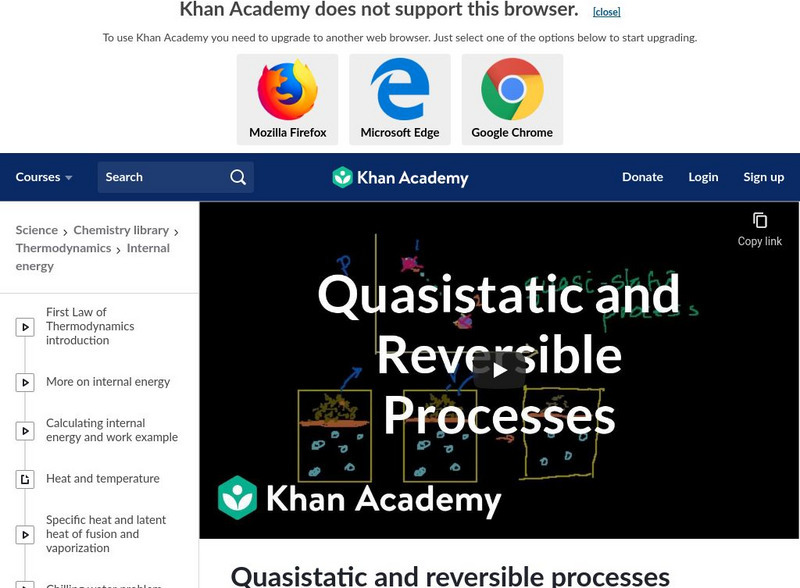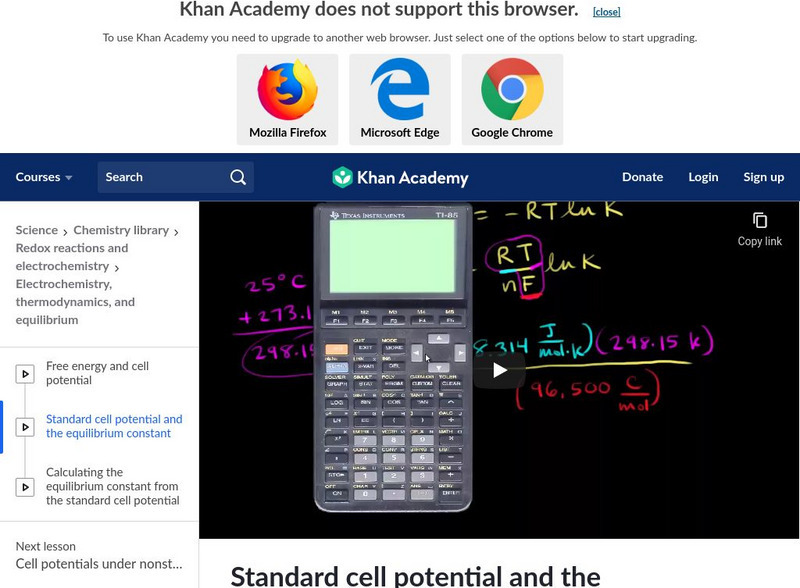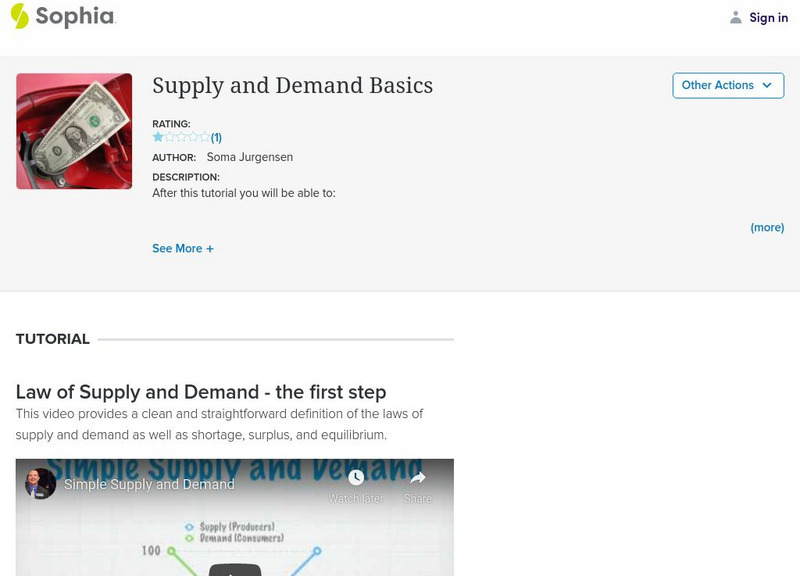Hi, what do you want to do?
Massachusetts Institute of Technology
Mit: Blossoms: Static Equilibrium
This video lesson will focus on systems that are said to be in equilibrium- that is, systems that are not allowed to move away from their original places or rotate about their axis. Students will learn about static equilibrium by...
Khan Academy
Khan Academy: Diffusion
A video lecture exploring diffusion. Understand how a concentration gradient causes molecules to move from an area of high concentration to low concentration without any energy expended. [6:07]
Khan Academy
Khan Academy: Reactions in Equilibrium
Use this tutorial to explore equilibrium reactions and constants. [14:50]
Khan Academy
Khan Academy: Comparing Q vs K Example
See a worked example using reaction quotient Q to predict how concentrations will shift so the reaction can get to equilibrium. [5:53]
Khan Academy
Khan Academy: Ka and Acid Strength
Learn how to write an equilibrium expression for an acid-base reaction and how to evaluate the strength of an acid using Ka. [9:18]
Khan Academy
Khan Academy: Introduction to Buffers
An introduction to buffer systems, which regulate pH in blood. [6:20]
Khan Academy
Khan Academy: Buffers, the Acid Rain Slayer
Define buffers and their compositions, and learn about carbonate buffering systems in nature, acid rain, pH of buffers, and titration. See an experiment using indicators to showcase just how awesome buffers are. [10:51]
Khan Academy
Khan Academy: Common Ion Effect and Buffers
See an example of calculating the pH of solution that is 1.00 M acetic acid and 1.00 M sodium acetate using ICE table. Also shown is another example of calculating pH of a solution that is 0.15 M ammonia and 0.35 M ammonium nitrate. [13:19]
Khan Academy
Khan Academy: Buffer Solution P H Calculations
See examples of calculating the pH of a buffer solution using the Henderson-Hasselbalch equation, including the pH of the buffer solution after adding some NaOH. [11:38]
Khan Academy
Khan Academy: P H and P Ka Relationship for Buffers
How the Henderson-Hasselbalch equation can be used to look at the ratio of conjugate acid and base using relationship between buffer pH and pKa. [7:50]
Khan Academy
Khan Academy: Buffer Capacity
Learn the definition of buffer capacity, and see an example showing why it depends on the absolute concentrations of the conjugate acid and base. [10:44]
Khan Academy
Khan Academy: Ways to Get a Buffer Solution
This tutorial describes the two main situations where you get a buffer: making a buffer for a specific pH by combining a weak acid and a salt containing the conjugate base, and using a neutralization reaction by combining a weak acid and...
Khan Academy
Khan Academy: Solubility and the Common Ion Effect
Using an ICE table to calculate molar solubility. [8:15]
Khan Academy
Khan Academy: Quasistatic and Reversible Processes
An explanation of keeping equilibrium using quasistatic and reversible processes. [14:36]
Khan Academy
Khan Academy: Work From Expansion
An explanation to show how expansion can cause work to be done. [12:43]
Khan Academy
Khan Academy: Work Done by Isothermic Process
Calculating the amount of work done to compare the heat added to a system and the isothermic process. [19:03]
Khan Academy
Khan Academy: Standard Cell Potential and the Equilibrium Constant
Find the relationship between standard cell potential and equilibrium constant K. [5:18]
Khan Academy
Khan Academy: Calculate the Equilibrium Constant From Standard Cell Potential
Walk through an example problem for calculating the equilibrium constant K using the standard cell potential. [9:37]
Sophia Learning
Sophia: Supply and Demand Basics
A series of excellent videos that explain the laws of supply and demand, shortage, surplus, equilibrium, slopes, and shifts. Includes a worksheet (PDF, requires Adobe Reader) and videos.
Khan Academy
Khan Academy: Small X Approximation for Small Kc
Understand when the small x approximation is useful for solving equilibrium problems. Find an example using the small x approximation when Kc is small. [9:37]
Khan Academy
Khan Academy: Small X Approximation for Large Kc
Guidelines and worked examples for using the small x approximation to solve equilibrium problems with large Kc values. [14:04]
Khan Academy
Khan Academy: Chemistry: Le Chatelier's Principle
A video lecture explaining Le Chatelier's Principle. The video shows how a reaction will favor one side of the reaction when stressed. [14:43]
Khan Academy
Khan Academy: Chemistry: Heterogeneous Equilibrium
A video lecture explaining that heterogeneous equilibrium occurs when the chemical reaction contains molecules with different states of matter. Students will learn how set-up finding the equilibrium constant by ignoring the solvent and...
Khan Academy
Khan Academy: Le Chatelier's Principle
Identify how Le Chatelier's Principle predicts changes in concentration when "stressing" reactions at equilibrium. [14:39]









